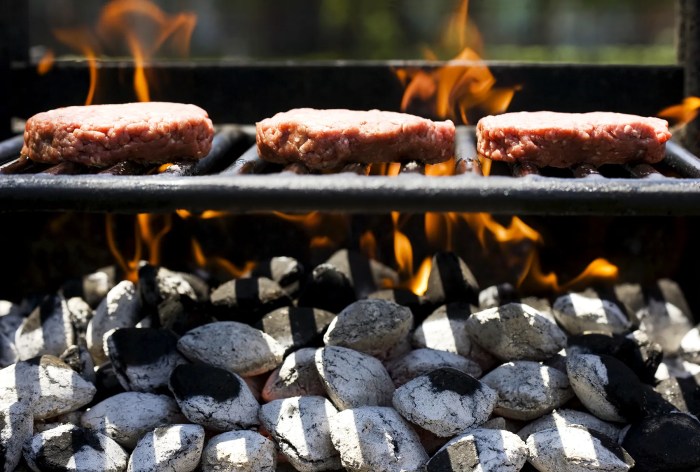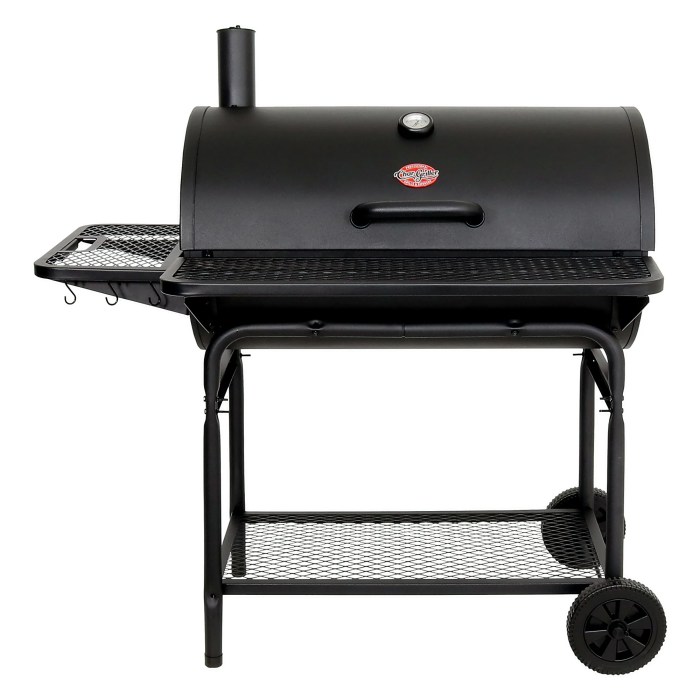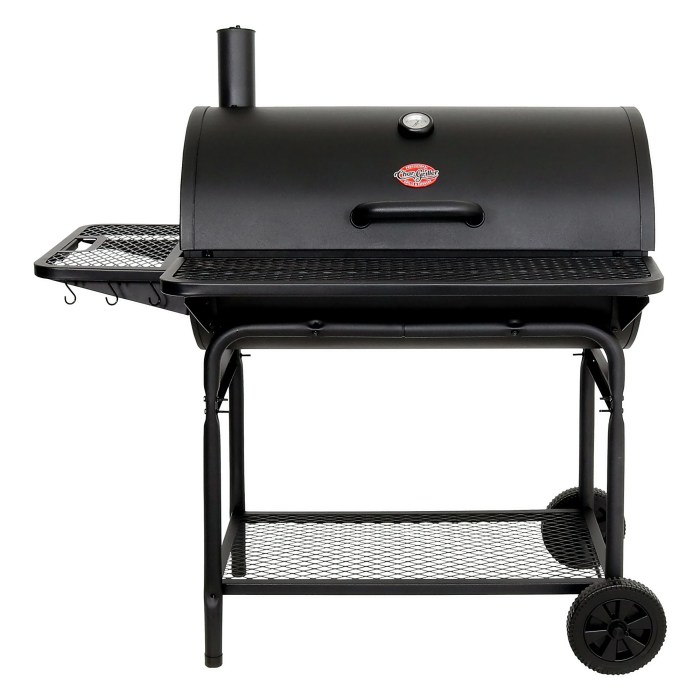DIY Coal Grill: A smoky, satisfying barbecue experience is within your reach with a DIY coal grill. You can enjoy the rich flavor of coal-fired grilling without breaking the bank or settling for a generic grill. Building your own grill is a rewarding project that allows you to customize it to your specific needs and preferences.
From choosing the right materials to mastering the art of fire management, this guide will take you through every step of the process. Whether you’re a seasoned grilling enthusiast or a beginner looking to try something new, building a DIY coal grill is an exciting adventure that will enhance your outdoor cooking experience.
Design Considerations

Building a coal grill involves careful planning and consideration of key design elements to ensure optimal performance, durability, and safety. This section will delve into essential design considerations, providing a step-by-step guide to crafting a functional and efficient coal grill.
Dimensions and Features
The dimensions of your coal grill will determine its cooking capacity and overall size. Consider the following factors when deciding on the dimensions:
- Cooking Area: The size of the grilling area should be sufficient for your cooking needs. A larger cooking area allows for more flexibility and the ability to grill multiple items simultaneously.
- Height: The height of the grill should be comfortable for you to work with. A standard height of 30-36 inches is generally suitable.
- Depth: The depth of the grill should be sufficient to accommodate the size of the coals and provide adequate space for airflow. A depth of 12-18 inches is a good starting point.
- Features: Consider adding features like a built-in thermometer, adjustable vents, and a removable ash pan for ease of cleaning and temperature control.
Ventilation and Airflow
Adequate ventilation and airflow are crucial for efficient combustion and heat distribution in a coal grill. This is achieved by strategically placing vents for air intake and exhaust.
- Air Intake: Vents located near the bottom of the grill allow fresh air to enter, fueling the fire.
- Air Exhaust: Vents at the top of the grill allow smoke and heat to escape, creating a chimney effect that draws air through the grill.
- Chimney Effect: The chimney effect is essential for proper airflow and maintaining consistent temperatures. The height of the chimney can influence the intensity of the fire.
Grates
The type of grate you choose will affect the grilling experience and the final result of your food.
- Cast Iron Grates: Cast iron grates are known for their durability and heat retention. They produce beautiful grill marks and are suitable for searing meats and vegetables.
- Stainless Steel Grates: Stainless steel grates are less prone to rust and easier to clean. They are also more resistant to warping than cast iron. However, they may not retain heat as well as cast iron.
- Wrought Iron Grates: Wrought iron grates are a good compromise between cast iron and stainless steel. They offer good heat retention and are durable. However, they can be more susceptible to rust.
Grilling Techniques
Mastering the art of grilling with a DIY coal grill involves understanding how to manage the fire and adjust the heat for different types of food. This section will guide you through the basics of starting and maintaining a coal fire, controlling the heat for various grilling methods, and grilling different types of food.
Starting and Maintaining a Coal Fire
Starting and maintaining a coal fire is crucial for successful grilling.
- Use high-quality charcoal briquettes for a long-lasting, even burn.
- Light the charcoal using a chimney starter or a lighter fluid.
- Once the coals are glowing red and covered in ash, they are ready for grilling.
- To maintain the fire, add more coals as needed.
- Adjust the vents on your grill to control the airflow and temperature.
Controlling Heat for Different Grilling Methods
The intensity of the heat directly impacts the cooking process and the final result.
- Direct Heat: This method involves placing the food directly over the hot coals, ideal for searing steaks, burgers, and vegetables.
- Indirect Heat: This method involves placing the food away from the direct heat, typically on a raised grill rack or in a covered grill. This is ideal for cooking larger cuts of meat, poultry, and fish that require longer cooking times and a more even cook.
- Two-Zone Grilling: This method involves dividing the grill into two zones, one hot and one cooler. This allows you to sear food over direct heat and then move it to the cooler zone to finish cooking.
Grilling Various Types of Food
Different types of food require different grilling techniques and heat levels.
- Steak: Sear steaks over direct high heat for a flavorful crust, then move them to the cooler side of the grill to finish cooking.
- Burgers: Grill burgers over medium heat, flipping them once they develop a crust.
- Chicken: Grill chicken over medium heat, flipping it once the skin is crispy.
- Fish: Grill fish over medium heat, skin side down, until it flakes easily.
- Vegetables: Grill vegetables over medium heat, flipping them occasionally until they are tender.
Maintenance and Cleaning: Diy Coal Grill

A well-maintained coal grill will provide you with years of enjoyable grilling experiences. Regular cleaning and maintenance are crucial to ensure its longevity and prevent any safety hazards. This section will guide you through the essential cleaning and maintenance practices for your DIY coal grill.
Ash Removal
Regular ash removal is crucial for maintaining the proper functioning of your coal grill. Ash buildup can obstruct airflow, leading to uneven heat distribution and potentially hindering the grilling process.
- After each grilling session, allow the grill to cool completely before attempting to remove the ash.
- Use a sturdy ash shovel or a dustpan and brush to collect the ash from the grill’s bottom.
- Dispose of the ash in a designated fire-safe container, as it can smolder for a long time.
- Consider using a grill ash vacuum for efficient and dust-free ash removal, especially for larger grills.
Grate Cleaning
The grilling grates are the most frequently used part of your grill and require regular cleaning to prevent food from sticking and ensure even cooking.
- Use a wire brush or a grill scraper to remove any food residue from the grates.
- For stubborn food particles, soak the grates in a solution of baking soda and water for a few hours.
- After cleaning, rinse the grates with water and dry them thoroughly.
- Consider applying a light coating of cooking oil to the grates to prevent rust and facilitate easy food release during future grilling sessions.
Preventing Rust and Corrosion
Rust and corrosion can significantly damage your grill, leading to its premature deterioration.
- After each grilling session, allow the grill to cool completely before storing it.
- Keep the grill covered when not in use, preferably with a waterproof grill cover.
- Store the grill in a dry and well-ventilated area to prevent moisture buildup.
- Consider applying a rust-resistant coating to the grill’s metal components for added protection.
Troubleshooting and Repairs
Even the most well-built DIY coal grill can encounter problems over time. This section covers common issues, how to diagnose them, and solutions to keep your grill in top shape.
Common Problems and Solutions
Troubleshooting common problems with DIY coal grills involves understanding the root cause and implementing appropriate solutions. Here are some frequent issues and their solutions:
- Uneven Heat Distribution: This can be caused by several factors, including unevenly placed coals, a poorly designed grill grate, or airflow problems.
- Solution: Evenly distribute coals in the firebox, ensure the grill grate is level and has adequate spacing for airflow, and adjust the vents to regulate airflow.
- Difficulty Starting the Fire: Starting a fire in a coal grill can be challenging, especially if the coals are damp or the airflow is restricted.
- Solution: Use dry charcoal and a chimney starter to quickly ignite the coals. Ensure proper airflow by opening the vents fully and using kindling to start the fire.
- Excessive Smoke: Too much smoke can indicate a problem with the fuel, the grill’s design, or the grilling technique.
- Solution: Use high-quality charcoal, avoid over-filling the firebox, and ensure adequate airflow by adjusting the vents.
- Rust Formation: Exposure to moisture can cause rust on the grill’s metal parts.
- Solution: Clean the grill regularly and apply a protective coating, such as oil or paint, to prevent rust.
Repairing Damaged Parts
If a part of your DIY coal grill is damaged, you can often repair or replace it yourself.
- Grill Grate: If the grill grate is bent or damaged, you can try to straighten it or replace it with a new one.
- Solution: Use a hammer and a block of wood to gently straighten a bent grate. If the damage is extensive, consider replacing the grate with a new one of similar size and material.
- Vents: Damaged vents can affect airflow and temperature control.
- Solution: If the vent is cracked or broken, replace it with a new one. Ensure the new vent fits securely and operates smoothly.
- Firebox: A damaged firebox can compromise the grill’s structural integrity and lead to safety issues.
- Solution: If the firebox is severely damaged, it may need to be replaced. Consult with a welding professional for repairs or replacement.
Environmental Impact

Coal grilling, while offering a distinct flavor profile and traditional cooking experience, comes with environmental considerations. Understanding the impact of coal on the environment and adopting responsible practices can help minimize its footprint.
Coal Combustion and Air Quality
Coal combustion releases various pollutants into the atmosphere, including:
- Carbon dioxide (CO2): A primary greenhouse gas contributing to climate change.
- Particulate matter (PM): Fine particles that can penetrate deep into the lungs, causing respiratory problems.
- Sulfur dioxide (SO2): A gas that contributes to acid rain and respiratory issues.
- Nitrogen oxides (NOx): Gases that contribute to smog and acid rain.
The amount of pollutants released depends on factors like coal quality, combustion efficiency, and grilling duration. Choosing high-quality coal with low sulfur content and ensuring proper airflow during grilling can help reduce emissions.
Responsible Disposal of Ashes and Waste, Diy coal grill
Proper disposal of coal ashes and waste is crucial to prevent environmental contamination:
- Avoid dumping ashes in landfills or waterways: Ashes contain heavy metals and other pollutants that can harm soil and water quality.
- Dispose of ashes in designated containers: Many communities offer designated disposal sites for coal ashes.
- Use ashes as fertilizer: Coal ashes can be used as a source of calcium and other nutrients for plants, but only after testing for harmful elements.
Minimizing the Environmental Footprint
Here are some tips to reduce the environmental impact of coal grilling:
- Use natural charcoal: Natural charcoal is produced from wood, which is a renewable resource.
- Choose briquettes made from sustainable sources: Look for briquettes made from recycled materials or sustainably harvested wood.
- Use a charcoal chimney starter: This method reduces the amount of time needed to light the coals, resulting in less smoke and emissions.
- Grill efficiently: Use the right amount of coal for the size of the grill and the food you’re cooking. Avoid using excessive coal.
- Consider alternative grilling methods: Explore gas grilling or electric grilling as more environmentally friendly options.
Building a DIY coal grill is an investment in delicious, smoky meals and an enjoyable weekend project. With careful planning and attention to detail, you can create a grill that reflects your personal style and provides years of grilling enjoyment. So gather your tools, choose your materials, and embark on this rewarding journey to create your own backyard barbecue haven.
Building a DIY coal grill can be a fun and rewarding project, especially if you’re looking for a way to add a touch of rustic charm to your backyard. You’ll need to carefully consider the materials and design, and one important aspect is ensuring proper support for the grill grate. This is where a well-constructed DIY clamp rack can be incredibly helpful.
A sturdy clamp rack will provide stability and prevent the grate from sagging, ensuring even cooking and a more enjoyable grilling experience.

